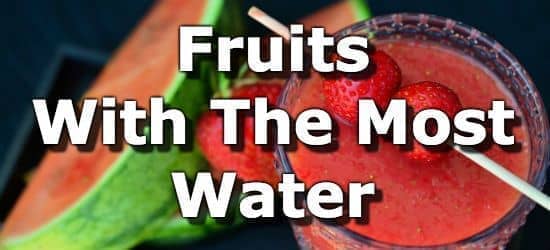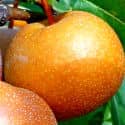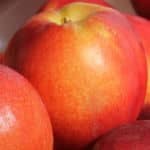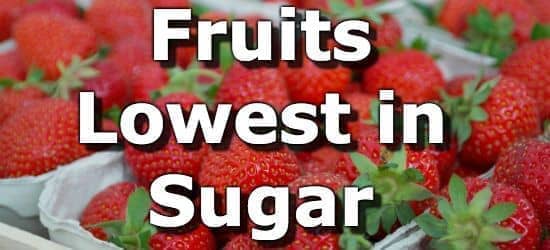17 Fruits Highest in Water

Water is an essential nutrient required to maintain homeostasis in our bodies. (1)
A deficiency in water, called dehydration, leads to headaches, loss of appetite, confusion, unexplained tiredness, and even seizures. (2) Excessive dehydration can even lead to death.
Conversely consuming too much water can lead to disorientation, confusion, nausea, vomiting, and in extreme cases, death. (3)
The U.S. Reference Dietary Intake (RDI) for water is 3.7 liters (130oz) per day for men and 2.7 liters (95oz) for women. (4) Though people who are active and under the sun should consume more.
Even though most vegetables provide more water than fruits, fruits are still a great source.
Fruits high in water include watermelon, strawberries, grapefruit, cantaloupes, peaches, Asian pears, blackberries, and papayas.
In addition to the 17 fruits listed below, you can see nutrient ranking of over 100 fruits and fruits juices high in water.
List of Fruits High in Water
-
Up to 91% water
 1. Watermelon + Add
1. Watermelon + Add
Water per Cup Water per 100g 140.8ml (5oz) 91.5ml (3.2oz) -
Up to 91% water
2. Strawberries + Add
Water per Cup Water per 100g 151ml (5.3oz) 91ml (3.2oz) -
Up to 91% water
 3. Grapefruit + Add
3. Grapefruit + Add
Water per Cup Water per 100g 209ml (7.4oz) 90.9ml (3.2oz) -
Up to 90% water
4. Cantaloupe + Add
Water per Cup Water per 100g 159.6ml (5.6oz) 90.2ml (3.2oz) -
Up to 89% water
 5. Peaches + Add
5. Peaches + Add
Water per Cup Water per 100g 136.9ml (4.8oz) 88.9ml (3.1oz) -
Up to 88% water
 6. Asian Pear + Add
6. Asian Pear + Add
Water per Fruit Water per 100g 107.7ml (3.8oz) 88.3ml (3.1oz) -
Up to 88% water
 7. Blackberries + Add
7. Blackberries + Add
Water per Cup Water per 100g 126.9ml (4.5oz) 88.2ml (3.1oz) -
Up to 88% water
8. Papaya + Add
Water per Cup Water per 100g 127.7ml (4.5oz) 88.1ml (3.1oz) -
Up to 88% water
 9. Nectarines + Add
9. Nectarines + Add
Water per Cup Water per 100g 125.3ml (4.4oz) 87.6ml (3.1oz) -
Up to 87% water
10. Plums + Add
Water per Cup Water per 100g 143.9ml (5.1oz) 87.2ml (3.1oz) -
Up to 87% water
 11. Oranges + Add
11. Oranges + Add
Water per Cup Water per 100g 156.2ml (5.5oz) 86.8ml (3.1oz) -
Up to 86% water
 12. Apricots + Add
12. Apricots + Add
Water per Cup Water per 100g 133.8ml (4.7oz) 86.4ml (3oz) -
Up to 86% water
13. Pineapple + Add
Water per Cup Water per 100g 141.9ml (5oz) 86ml (3oz) -
Up to 86% water
 14. Raspberries + Add
14. Raspberries + Add
Water per Cup Water per 100g 105.5ml (3.7oz) 85.8ml (3oz) -
Up to 86% water
15. Apples + Add
Water per Cup Water per 100g 107ml (3.8oz) 85.6ml (3oz) -
Up to 84% water
16. Blueberries + Add
Water per Cup Water per 100g 124.6ml (4.4oz) 84.2ml (3oz) -
Up to 83% water
 17. Mangos + Add
17. Mangos + Add
Water per Cup Water per 100g 137.7ml (4.9oz) 83.5ml (2.9oz)
From the Nutrient Ranking Tool
Use the ranking tool links below to select foods and create your own food list to share or print.
- Foods High in Water
- Foods Low in Water
- Vegetables High in Water
- Fruits High in Water
- Vegetarian Foods High in Water
- Nuts High in Water
- Grains High in Water
- Beans High in Water
- Dairy High in Water
- Breakfast Cereals High in Water
- Fast Foods High in Water
View more nutrients with the nutrient ranking tool, or see ratios with the nutrient ratio tool.
Related
Data Sources and References
- Armstrong LE, Ganio MS, Klau JF, Johnson EC, Casa DJ, Maresh CM. Biobehavioral variation in human water needs: How adaptations, early life environments, and the life course affect body water homeostasis Appl Physiol Nutr Metab. 2014 Feb;39(2):138-44. doi: 10.1139/apnm-2012-0369. Epub 2013 Jul 29. 24476468
- National Library of Medicine - Adult Dehydration by Kory Taylor and Elizabeth B. Jones.
- National Library of Medicine - Water Toxicity Basil V. Peechakara and Mohit Gupta.
- Institute of Medicine Reference Intakes for Water
Simplify Nutrition Tracking with MyFoodData!
Speedy Tools and Detailed Data FREEEasily analyze your meals to find the best foods for your goals.
✅ Use our recipe nutrition calculator and nutrition comparison tool.
✅ Access expert nutrition data tools and in-depth articles.
✅ Log foods and organize your recipes with a free account.

 Next ➞
Next ➞
